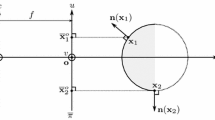Abstract
Basic steps to 3-D scene analysis may be encoded by qualitative rules of reasoning specifying assumptions (a model description) and a list of some 2-D or 3-D features in the premise, and one or several feature(s) in the conclusion for which a certain constraint may be derived. In integrative approaches, cp. for example Aloimonos and Shulman (1989) and Kanatani (1990), the list in the premise consists of at least two features, as local displacement (optical flow), texture, or lighting direction. Such rules are verified by combining theorems which may also be used to design derivational algorithms. Rule, theorem, and algorithm constitute a derivational unit which has to be considered in detail for analyzing its potential power for complex solutions in Computer Vision. The evaluation of such a derivational unit, resp. its qualitative rule, is possible via the specified algorithm (time complexity, numeric stability, etc.), and its behavior for selected classes of scenes. In this paper, the proposed general approach of the study of derivational units is illustrated by the discussion of some integrative approaches for shape analysis using local displacement, intensity ratios, lighting direction, etc., as features in the premise.
Similar content being viewed by others
References
Aloimonos, J., and D. Shulman, 1989, Integration of Visual Modules, Boston: Academic Press.
Brinkmann, H., 1991. Flächeninhalte von projizierten polygonalen 3-D Oberflächensegmenten. CV-Bericht 1, Fachgruppe CV, FB 20 (Informatik), TU Berlin.
Horn, B. K. P., 1986. Robot Vision, Cambridge: The MIT Press.
Kanatani, K., 1990. Group-Theoretical Methods in Image Understanding, Berlin: Springer.
Klette, R., 1992a, “A framework to computer vision research,” Machine Graphics & Vision,1, 331–341.
Klette, R., 1992b. “Integrative Approaches to ‘Shape from Motion’,” in: Proceed. Theoretical Foundations of Computer Vision (R. Klette, W. G. Kropatsch, eds.), Akademie Verlag 1992, Berlin, pp. 203–214.
Mehren, D., 1992, Einsatzanalyse für ausgewählte Verfahren des aggregierten Stereo. CV-Bericht 9, Fachgruppe CV, FB 20 (Informatik), TU Berlin.
Muller, D. E., 1956, “A method for solving algebraic equations using an automatic computer,” Math. Tables Aids Comp.,10, 208–215.
Rodehorst, V., 1992, Vertiefende Analyse eines Gestalts-Constraints von Aloimonos und Shulman. CV-Bericht 8, Fachgruppe CV, FB 20 (Informatik), TU Berlin.
Additional information
Fachgebiet Computer Vision, Institut für Technische Informatik im FB 20, Technische Universität Berlin, Franklinstr. 28/29, 1000 Berlin 10. Published in Kibernetika i Sistemnyi Analiz, No. 4, pp. 38–54, July–August, 1995.
Rights and permissions
About this article
Cite this article
Klette, R. Qualitative vision rules, combining theorems, and derivational algorithms. Cybern Syst Anal 31, 506–523 (1995). https://doi.org/10.1007/BF02366406
Received:
Issue Date:
DOI: https://doi.org/10.1007/BF02366406




